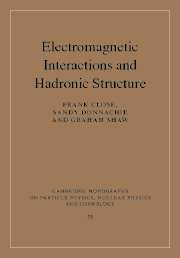Book contents
- Frontmatter
- Contents
- List of contributors
- Preface
- 1 Quark models of hadrons and issues in quark dynamics
- 2 Elastic form factors
- 3 Electromagnetic excitations of nucleon resonances
- 4 Meson radiative decays
- 5 Intermediate-energy photoproduction
- 6 Chiral perturbation theory
- 7 Spin structure functions
- 8 Diffraction and colour dipoles
- 9 Generalized parton distributions
- 10 Quark–hadron duality
- 11 Colour transparency
- Index
9 - Generalized parton distributions
Published online by Cambridge University Press: 15 August 2009
- Frontmatter
- Contents
- List of contributors
- Preface
- 1 Quark models of hadrons and issues in quark dynamics
- 2 Elastic form factors
- 3 Electromagnetic excitations of nucleon resonances
- 4 Meson radiative decays
- 5 Intermediate-energy photoproduction
- 6 Chiral perturbation theory
- 7 Spin structure functions
- 8 Diffraction and colour dipoles
- 9 Generalized parton distributions
- 10 Quark–hadron duality
- 11 Colour transparency
- Index
Summary
Generalized parton distributions (GPDs) have been recognized as a versatile tool to investigate and describe the structure of hadrons at the quark–gluon level. They are closely related to conventional parton distributions and also to hadronic form factors, but contain information that cannot be accessed with either of these quantities. Important areas where GPDs can provide new insight are the spatial distribution of quarks and gluons within a hadron and the contribution of quark orbital angular momentum to the nucleon spin. In this chapter we present the basics of the theory of GPDs, the dynamics they encode and the efforts of phenomenology and experiment to measure them in exclusive scattering processes. We do not attempt to give a comprehensive account of the vast literature and refer to the reviews [1–5] for more detailed discussion and references.
Experimental access to GPDs is provided in suitable hard scattering processes with exclusive final states, especially in processes initiated by a highly virtual photon. Recall that the cross section for inclusive deep inelastic scattering (DIS) is related to the amplitude for forward Compton scattering, γ* p → γ* p, via the optical theorem. In the Bjorken limit of large Q2 = -q2 at fixed xB = Q2/(2pq), this amplitude factorizes into a short-distance process involving quarks and gluons and the usual parton distributions which encode the structure of the target hadron at quark–gluon level. At leading order in αs one then obtains the handbag diagram in figure 9.1(a)
- Type
- Chapter
- Information
- Electromagnetic Interactions and Hadronic Structure , pp. 359 - 423Publisher: Cambridge University PressPrint publication year: 2007
- 2
- Cited by



